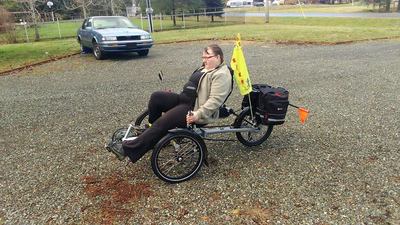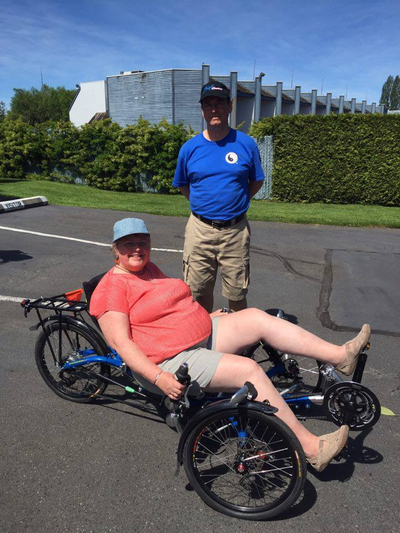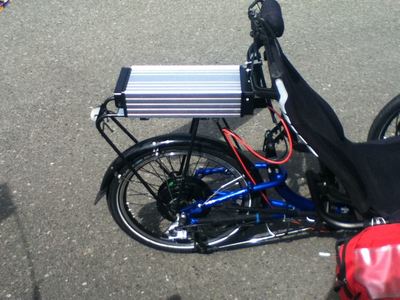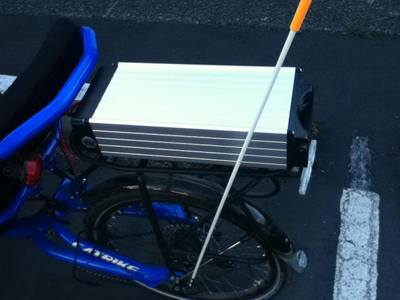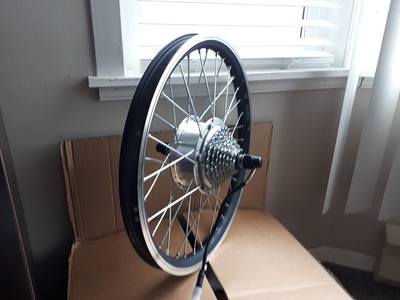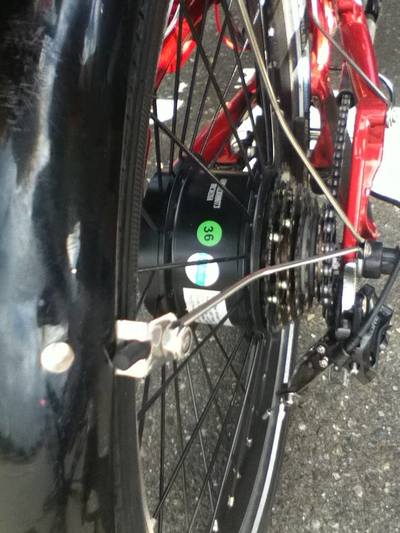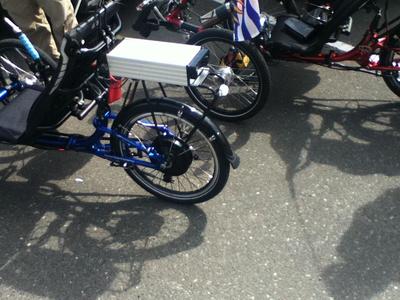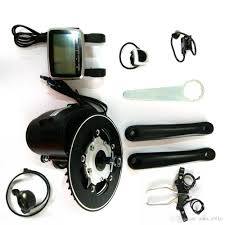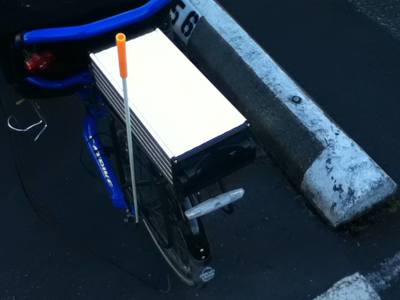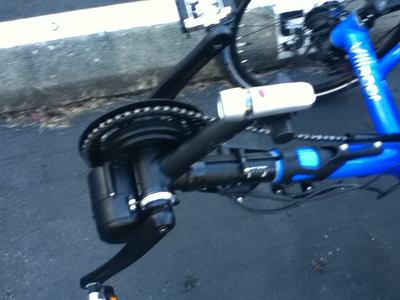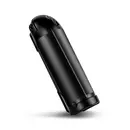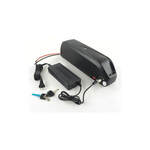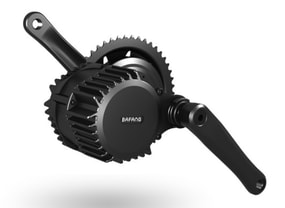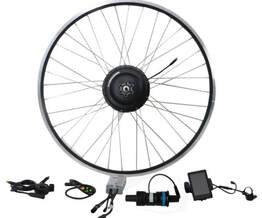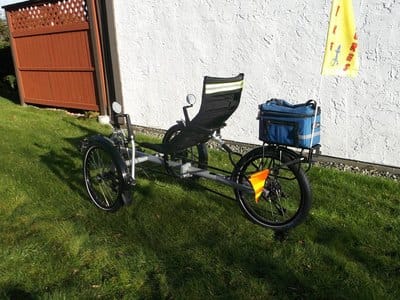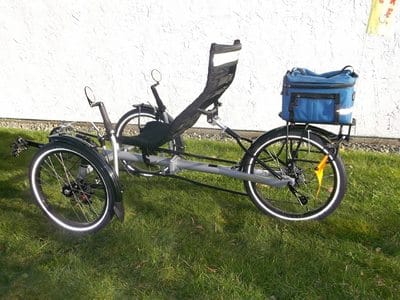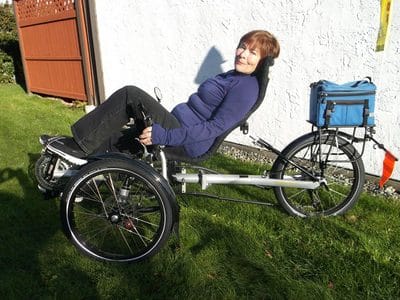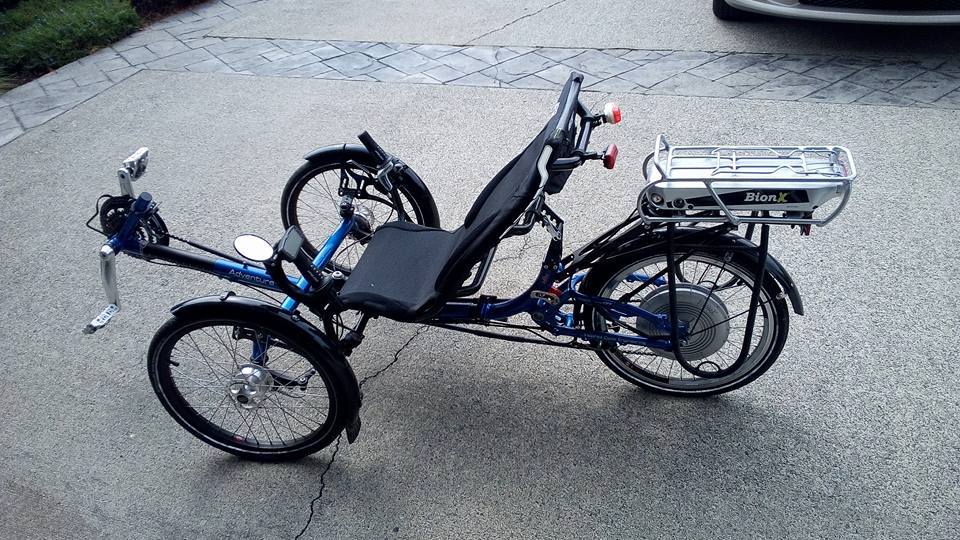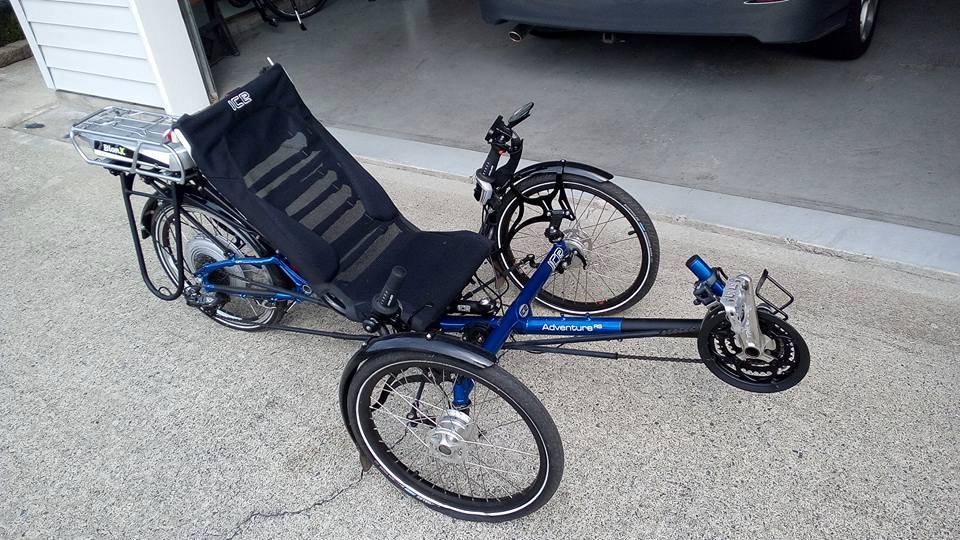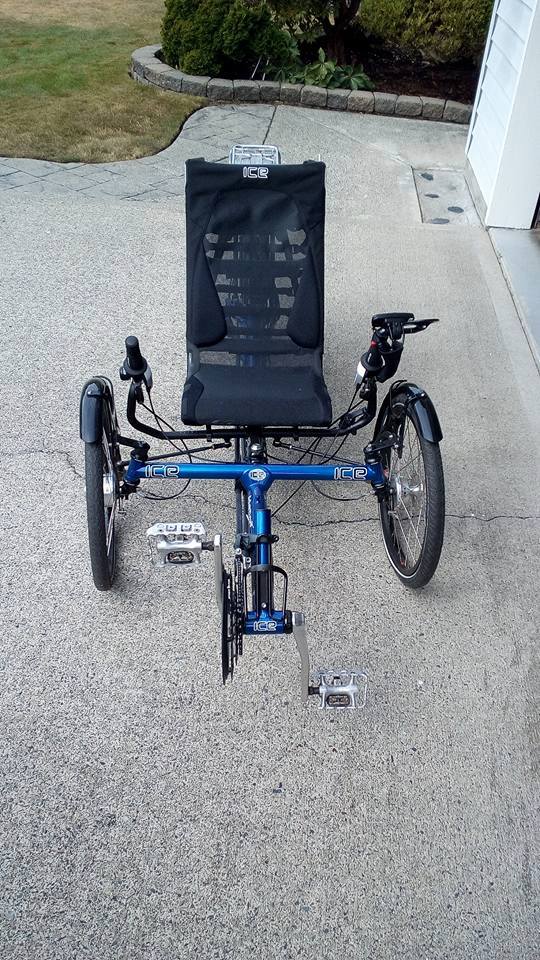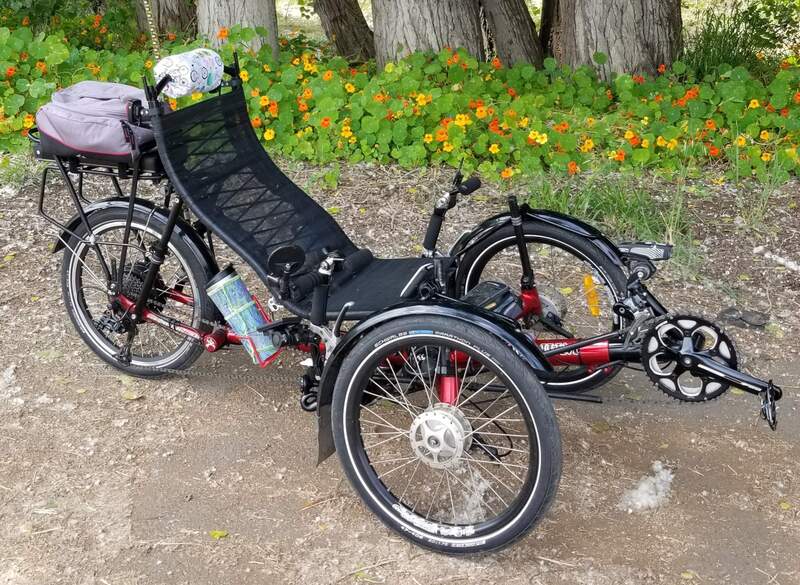CHOOSING AN ELECTRIC ASSIST
ELECTRIC TRIKES - Are you considering an Electric Assist for your trike? You have many options & the information can be daunting. Watts? Amps? Sine Wave? Geared? Brushless? etc. etc. Here is all you need to know to make an informed choice.
For Trikes you have 2 main choices for converting to an Electric Assist. A Motor in the Rear Wheel or a Motor that drives your Chain.
To control the power going ultimately to your back wheel you need a control device. This can be a 'hard control' throttle like an ON/OFF switch or a 'soft control' similar to a volume knob on your stereo. (This describes how they operate not what the actual control is.)
Throttle - Can be a Twist Grip or Thumb Paddle. These have a tendency to be either ON or OFF.
P.A.S. - Pedal Assist Sensor is connected to your Crank & detects when your pedals are moving. These tend to be a softer assist adding power gradually when needed. The better sensors add power based on how much effort you are putting into your pedals while the cheaper units increase the power required at the touch of a button.
You will still need to operate the gearing on your trike to climb hills. Remember, for most systems they are an 'Assist' & not intended to turn your Trike into a motor cycle. This can be done though with much more powerful systems.
Which system is Better? - Either system works well with cost being within $200. of each other. The Crank Systems balance the weight better on your trike which is better for cornering. The motor in wheel systems can run quieter, keep everything compact & the noise behind you. Just be aware of the risk of tipping over on high speed turns if all the weight is over your back wheel.
Flat Tires - Flat tires on any bike or trike can be a royal pain but on an E Assist trike can be downright dangerous. Add into the mix of working down low on the ground, traffic whizzing by in bad weather or poor visibility, the need for a second pair of hands while you hold the trike in the air, fit your lock washers, position your wheel axle in the drop outs, route your derailleur & chain correctly, tighten everything up & connect your signal cable & it is easy to imagine things could go wrong very quickly. For this reason alone I recommend using tire liners to prevent flats from happening in the first place. Some liners in the early days had a reputation for causing friction flats where the liner wore through the tube. Modern Tire Liners have polished edges, are pliable soft plastic & seem to have overcome that problem. I recommend Mr. Tuffy's or Stop Flat 2 liners which I believe are the same product sold under different names. Stay away from the hard rigid plastic liners as these will cause friction flats. If you are still one of the skeptics about tire liners then buy the best flat prevention tire on the market, Schwalbe Marathon Plus. The only tire I know of with a built in 5mm thick flat prevention strip. Crank Drive motors will not change the steps required to fix a rear flat tire but an in wheel motor will and if you do manage to get a second pair of hands to help you out, they may not know how your cables or other components need to be connected. If you have physical limitations that might make it difficult for you to bend over, crouch or work on the ground, do yourself a favour & install the tire liners.
Batteries - Your biggest expense by far will be the Lithium Battery. With reasonable care they will last for 5 years or more so your annual operating cost becomes minimal even if you replace your battery after 5 years. Once you know what your battery range will be just remember to halve that so you have enough power for the return trip home. On most systems this can be 50-60kms of assisted riding while still staying within your safe operating zone. You should aim for 80% of your batteries maximum capacity to get maximum life out of your battery. A guage on your display will tell you how much battery charge you have left.
Most ratings for Batteries consider the battery exhausted once it will only charge to 70% of it's maximum capacity so it is quite possible if you only make 20km trips your battery could last several years longer. Of course if your route includes killer hills where your motor is doing most of the work your range & battery life may not be what is advertised.
Should I choose a Hub Motor or Crank Drive? - This is a tough question to answer. Both systems have seen wide use in the E bike market from Manufacturers & After Market Conversions. Adding a Power Assist to your Bike or Trike is going to add weight. This weight comes from the Motor, Battery & Electrical Components. The bigger the Motor or Battery the more weight you will have to contend with. This additional weight will affect your handling, braking, ride qualities, tire life & make it more of a chore lifting your bike up & down stairs or loading it onto a bike rack. If you plan on riding on trails at the beach or lake, getting to your starting point can mean you need the help of another person if you go with some systems weighing 50 or 60 lbs./25 kgs. For that reason I always recommend going with as small a motor as you need with a battery that isn't over taxed with your range in mind. Most of the systems I install weigh around 20 lbs./9 kgs. including the battery but this weight should still be balanced on your ride. Too much weight at one end can cause you problems & you don't want to discover that your bike or trike doesn't handle or brake well on a downhill bend in the rain.
Front Wheel Motor - Will add about 8 lbs./3 kgs. to the front end of your bike or Delta Trike.
Advantages -
Balances your weight better between front & rear.
Allows use of Triple Chain Rings for a wider gear range.
Allows use of Internal Gear Hubs and Cranksets.
Allows Battery to be mounted in the most convenient location.
Flat Tires are easier to fix.
Disadvantages -
Can get light & lose traction going up hill or on slippery surfaces. (Sand, Snow, Ice, Wet, Painted Road Lines)
Can effect steering from torque input from the motor.
Be aware of starting up with your steering turned.
Rear Wheel Motor - Will add about 10 lbs./4 kgs. to the rear of your bike or Tadpole Trike.
Advantages -
Helps to have weight over your driving wheel for traction on slippery surfaces.
Improves handling & braking over Front Wheel Motors.
Keeps the whine of some motors behind you so any noise is less intrusive.
Can be used with Internal Cranksets like Shlumpf, Patterson or Efneo.
Disadvantages -
More complicated install, sometimes requiring modifying your existing drive train.
Cannot always be installed on bikes/trikes with suspension.
Flat repairs require more dis-assembly & re-assembly.
Battery should be placed in frame for better weight distribution.
Crank Drives - (Commonly known as Mid-Drives ) Adds 8 lbs. / 3 kgs. to the middle of your Bike.
Advantages -
Puts weight down low & in the center of your frame where it should be for better handling & braking. (On Bikes)
It offsets the weight of a battery & hub motor in the rear for better handling & braking. (On Trikes)
Offers the smoothest application of power.
Allows use of Internal Gear Hubs.
Allows for the most convenient location of your battery but weight can be up high so be careful of center of gravity.
Does not affect the number of steps when changing a flat tire.
Disadvantages -
Takes the place of your triple chain ring so may reduce your Gear Range.
Can have the noise of the motor in front of you (On Trikes)
May increase the wear on your chain & sprockets.
How much power should I choose? - In Canada the legal on road limit is 500 watts. In the U.S. it is 750 watts & in most European countries it is 250 watts. I recommend a 350 watt, brushless, geared motor system as it keeps your weight low while still providing enough power for your assist going up hills.
How much weight are we talking? - The systems I install will add about 20 lbs./9kgs. to the weight of your trike. This includes the battery weight. While it may not seem like a lot, lifting your trike to load it into your car or muscle it through your doorway is enough to make you wish for something lighter or it may put your back out. Adding a Higher Wattage motor will increase the weight considerably as will adding a larger battery.
What kind of Motor? - There are 2 types of Hub Motors for in wheel installations. A Direct Drive Motor or a Brushless, Geared Motor.
Direct Drive Motors - tend to be heavy, large & produce less torque for hill climbing. They also make it harder to pedal your trike without any power being applied. This is a distinct disadvantage should you find yourself out on the road & run out of battery power or develop a fault. They usually cost less than Brushless, Geared Motors but run almost silent, have almost no moving parts & will run forever without any needed maintenance inside.
Brushless, Geared Motors - are much lighter & produce more torque by use of internal gears. They tend to be a little more expensive than Direct Drive motors but will put less strain on your entire driveline & battery. Another advantage of the Geared Hub Motors is you can operate your trike without any, just a little or with maximum power applied. If you run out of power or develop a fault out on the road you can still pedal your trike home or use your throttle with the motor.
What About Regenerative Braking? - Regen Braking is supposed to put power back into your battery when you are coasting downhill or braking. Since it is only available on Direct Drive Motors it is not recommended for the reasons above as well as the following. - It adds even more weight & complexity to your system with the potential for more things to go wrong. As you are adding more weight & cannot ride very well without any power assist engaged you end up paying more for a system that is actually delivering less because it is heavier & more difficult to ride, maintain & repair. On top of that most dedicated systems require you to use proprietary parts ONLY available from the manufacturer at a premium price. You are much safer financially using an open source system where you can buy replacement parts online from any of a 100 re-sellers.
How much power do I need or want? - That depends on several variables such as how much weight you are pulling? What’s the terrain like where you ride? How much speed do you want? How far do you want to ride? How many features do you want? Your Maximum budget?
A Basic 10 amp/hr. 250 watt Motor with Pedal Assist is the most economical. This will give you a gentle push up hills & be the lightest, easiest to live with system with not much of anything to go wrong or need in the way of maintenance or repairs. Range should be around 40 kms/25 miles. You should only choose this system if you live in an area with small hills or your total riding weight is under 100 kgs.
A Moderate 13 amp/hr. System with a 500 watt motor, Pedal Assist, Throttle, LCD Display, will give you a GOOD boost, reasonable range of 40 miles/60kms, require occasional maintenance & will add about 10kgs to your total riding weight. You should choose this system if your total riding weight is under 150kgs. and you ride in an area with average on road hills.
Heavy Duty 18 amp/hr. System with a 750 watt motor, with Pedal Assist, Throttle, LCD Display & Installation Kit will give STRONG boost & power up most any hill you are likely to encounter. You should choose this system if your riding weight is on the heavy side & you want great moped like performance & not much of a bike work out. Added weight is about 12 kgs. Range with this system will be about 65 kms.
For Trikes you have 2 main choices for converting to an Electric Assist. A Motor in the Rear Wheel or a Motor that drives your Chain.
To control the power going ultimately to your back wheel you need a control device. This can be a 'hard control' throttle like an ON/OFF switch or a 'soft control' similar to a volume knob on your stereo. (This describes how they operate not what the actual control is.)
Throttle - Can be a Twist Grip or Thumb Paddle. These have a tendency to be either ON or OFF.
P.A.S. - Pedal Assist Sensor is connected to your Crank & detects when your pedals are moving. These tend to be a softer assist adding power gradually when needed. The better sensors add power based on how much effort you are putting into your pedals while the cheaper units increase the power required at the touch of a button.
You will still need to operate the gearing on your trike to climb hills. Remember, for most systems they are an 'Assist' & not intended to turn your Trike into a motor cycle. This can be done though with much more powerful systems.
Which system is Better? - Either system works well with cost being within $200. of each other. The Crank Systems balance the weight better on your trike which is better for cornering. The motor in wheel systems can run quieter, keep everything compact & the noise behind you. Just be aware of the risk of tipping over on high speed turns if all the weight is over your back wheel.
Flat Tires - Flat tires on any bike or trike can be a royal pain but on an E Assist trike can be downright dangerous. Add into the mix of working down low on the ground, traffic whizzing by in bad weather or poor visibility, the need for a second pair of hands while you hold the trike in the air, fit your lock washers, position your wheel axle in the drop outs, route your derailleur & chain correctly, tighten everything up & connect your signal cable & it is easy to imagine things could go wrong very quickly. For this reason alone I recommend using tire liners to prevent flats from happening in the first place. Some liners in the early days had a reputation for causing friction flats where the liner wore through the tube. Modern Tire Liners have polished edges, are pliable soft plastic & seem to have overcome that problem. I recommend Mr. Tuffy's or Stop Flat 2 liners which I believe are the same product sold under different names. Stay away from the hard rigid plastic liners as these will cause friction flats. If you are still one of the skeptics about tire liners then buy the best flat prevention tire on the market, Schwalbe Marathon Plus. The only tire I know of with a built in 5mm thick flat prevention strip. Crank Drive motors will not change the steps required to fix a rear flat tire but an in wheel motor will and if you do manage to get a second pair of hands to help you out, they may not know how your cables or other components need to be connected. If you have physical limitations that might make it difficult for you to bend over, crouch or work on the ground, do yourself a favour & install the tire liners.
Batteries - Your biggest expense by far will be the Lithium Battery. With reasonable care they will last for 5 years or more so your annual operating cost becomes minimal even if you replace your battery after 5 years. Once you know what your battery range will be just remember to halve that so you have enough power for the return trip home. On most systems this can be 50-60kms of assisted riding while still staying within your safe operating zone. You should aim for 80% of your batteries maximum capacity to get maximum life out of your battery. A guage on your display will tell you how much battery charge you have left.
Most ratings for Batteries consider the battery exhausted once it will only charge to 70% of it's maximum capacity so it is quite possible if you only make 20km trips your battery could last several years longer. Of course if your route includes killer hills where your motor is doing most of the work your range & battery life may not be what is advertised.
Should I choose a Hub Motor or Crank Drive? - This is a tough question to answer. Both systems have seen wide use in the E bike market from Manufacturers & After Market Conversions. Adding a Power Assist to your Bike or Trike is going to add weight. This weight comes from the Motor, Battery & Electrical Components. The bigger the Motor or Battery the more weight you will have to contend with. This additional weight will affect your handling, braking, ride qualities, tire life & make it more of a chore lifting your bike up & down stairs or loading it onto a bike rack. If you plan on riding on trails at the beach or lake, getting to your starting point can mean you need the help of another person if you go with some systems weighing 50 or 60 lbs./25 kgs. For that reason I always recommend going with as small a motor as you need with a battery that isn't over taxed with your range in mind. Most of the systems I install weigh around 20 lbs./9 kgs. including the battery but this weight should still be balanced on your ride. Too much weight at one end can cause you problems & you don't want to discover that your bike or trike doesn't handle or brake well on a downhill bend in the rain.
Front Wheel Motor - Will add about 8 lbs./3 kgs. to the front end of your bike or Delta Trike.
Advantages -
Balances your weight better between front & rear.
Allows use of Triple Chain Rings for a wider gear range.
Allows use of Internal Gear Hubs and Cranksets.
Allows Battery to be mounted in the most convenient location.
Flat Tires are easier to fix.
Disadvantages -
Can get light & lose traction going up hill or on slippery surfaces. (Sand, Snow, Ice, Wet, Painted Road Lines)
Can effect steering from torque input from the motor.
Be aware of starting up with your steering turned.
Rear Wheel Motor - Will add about 10 lbs./4 kgs. to the rear of your bike or Tadpole Trike.
Advantages -
Helps to have weight over your driving wheel for traction on slippery surfaces.
Improves handling & braking over Front Wheel Motors.
Keeps the whine of some motors behind you so any noise is less intrusive.
Can be used with Internal Cranksets like Shlumpf, Patterson or Efneo.
Disadvantages -
More complicated install, sometimes requiring modifying your existing drive train.
Cannot always be installed on bikes/trikes with suspension.
Flat repairs require more dis-assembly & re-assembly.
Battery should be placed in frame for better weight distribution.
Crank Drives - (Commonly known as Mid-Drives ) Adds 8 lbs. / 3 kgs. to the middle of your Bike.
Advantages -
Puts weight down low & in the center of your frame where it should be for better handling & braking. (On Bikes)
It offsets the weight of a battery & hub motor in the rear for better handling & braking. (On Trikes)
Offers the smoothest application of power.
Allows use of Internal Gear Hubs.
Allows for the most convenient location of your battery but weight can be up high so be careful of center of gravity.
Does not affect the number of steps when changing a flat tire.
Disadvantages -
Takes the place of your triple chain ring so may reduce your Gear Range.
Can have the noise of the motor in front of you (On Trikes)
May increase the wear on your chain & sprockets.
How much power should I choose? - In Canada the legal on road limit is 500 watts. In the U.S. it is 750 watts & in most European countries it is 250 watts. I recommend a 350 watt, brushless, geared motor system as it keeps your weight low while still providing enough power for your assist going up hills.
How much weight are we talking? - The systems I install will add about 20 lbs./9kgs. to the weight of your trike. This includes the battery weight. While it may not seem like a lot, lifting your trike to load it into your car or muscle it through your doorway is enough to make you wish for something lighter or it may put your back out. Adding a Higher Wattage motor will increase the weight considerably as will adding a larger battery.
What kind of Motor? - There are 2 types of Hub Motors for in wheel installations. A Direct Drive Motor or a Brushless, Geared Motor.
Direct Drive Motors - tend to be heavy, large & produce less torque for hill climbing. They also make it harder to pedal your trike without any power being applied. This is a distinct disadvantage should you find yourself out on the road & run out of battery power or develop a fault. They usually cost less than Brushless, Geared Motors but run almost silent, have almost no moving parts & will run forever without any needed maintenance inside.
Brushless, Geared Motors - are much lighter & produce more torque by use of internal gears. They tend to be a little more expensive than Direct Drive motors but will put less strain on your entire driveline & battery. Another advantage of the Geared Hub Motors is you can operate your trike without any, just a little or with maximum power applied. If you run out of power or develop a fault out on the road you can still pedal your trike home or use your throttle with the motor.
What About Regenerative Braking? - Regen Braking is supposed to put power back into your battery when you are coasting downhill or braking. Since it is only available on Direct Drive Motors it is not recommended for the reasons above as well as the following. - It adds even more weight & complexity to your system with the potential for more things to go wrong. As you are adding more weight & cannot ride very well without any power assist engaged you end up paying more for a system that is actually delivering less because it is heavier & more difficult to ride, maintain & repair. On top of that most dedicated systems require you to use proprietary parts ONLY available from the manufacturer at a premium price. You are much safer financially using an open source system where you can buy replacement parts online from any of a 100 re-sellers.
How much power do I need or want? - That depends on several variables such as how much weight you are pulling? What’s the terrain like where you ride? How much speed do you want? How far do you want to ride? How many features do you want? Your Maximum budget?
A Basic 10 amp/hr. 250 watt Motor with Pedal Assist is the most economical. This will give you a gentle push up hills & be the lightest, easiest to live with system with not much of anything to go wrong or need in the way of maintenance or repairs. Range should be around 40 kms/25 miles. You should only choose this system if you live in an area with small hills or your total riding weight is under 100 kgs.
A Moderate 13 amp/hr. System with a 500 watt motor, Pedal Assist, Throttle, LCD Display, will give you a GOOD boost, reasonable range of 40 miles/60kms, require occasional maintenance & will add about 10kgs to your total riding weight. You should choose this system if your total riding weight is under 150kgs. and you ride in an area with average on road hills.
Heavy Duty 18 amp/hr. System with a 750 watt motor, with Pedal Assist, Throttle, LCD Display & Installation Kit will give STRONG boost & power up most any hill you are likely to encounter. You should choose this system if your riding weight is on the heavy side & you want great moped like performance & not much of a bike work out. Added weight is about 12 kgs. Range with this system will be about 65 kms.
|
10 amp/hr. Bottle Battery
The ideal 36 volt battery for your Torque Sensor motor as you get extended range from the better efficiency allowing you to use a smaller, lighter battery. Frame mount to keep the weight down low on your trike. Good for about 40 kms. of moderate use. Name Brand Cells like Samsung, LG or Panasonic. Small Compact Batteries run about $300. cdn. |
|
13 amp/hr Hailong Battery
For the bigger Grunt of 48 volt motors, you need a bigger punch delivered. With the Cadence Sensor Motors, they do not deliver the power as efficiently as the Torque Sensor Motors so you need a bigger battery to compensate. Slightly heavier & should be mounted in your frame for better weight distribution. Still made with Brand Name Cells but not much of an increase in range. Maybe 60 kms, of moderate use. Battery Prices run $600. cdn. |
What we like about the Bafang - A nice quality Kit that has been around since 2014 with millions sold. Low end grunt will get you up hills with lots of torque.
What we don't like - Rough Power Delivery, factory setting is more like an ON/OFF switch. Programming means the motor has lag time when you stop adding power. A little more complicated to do your own repairs. Installation has more connection points & will damage your Bottom Bracket Shell with Indentations.
* New Programming is now available making Bafang Motors much smoother in their power delivery. *
What we like about Hub Motors - If you like smooth power delivery, adequate torque, the flexibility to go either Torque Sensor or Cadence Sensor & have the security of having your motor & throttle as a back up over Mid Drive Power Kits, then hub motors may be for you.
What we don't like - Geared Hub Motors need you to also assist with pedaling & using your hub gears when climbing. On a front wheel installation, this can mean you may have trouble getting adequate traction in slippery conditions. On Delta Trikes with a rear 2 wheel drive, this probably won't be a problem but with a single rear drive it can be.
!!! OUR RECOMMENDATION !!! Now you can have an Internal Gear Hub with a mild Power Assist & eliminate the derailleur, external gears & constant fine tuning of your shifting. Imagine a system that you can simply get on and ride with a once per year tune up. Combined with your Front Hub or Mid Drive Motor, this is Power Assist at its most convenient. Shift whether moving or stopped. No more getting stuck in a high gear. No more predicting which low gear is needed in front of a hill. Learn more on our Internal Gear Hub Page.
What we don't like - Rough Power Delivery, factory setting is more like an ON/OFF switch. Programming means the motor has lag time when you stop adding power. A little more complicated to do your own repairs. Installation has more connection points & will damage your Bottom Bracket Shell with Indentations.
* New Programming is now available making Bafang Motors much smoother in their power delivery. *
What we like about Hub Motors - If you like smooth power delivery, adequate torque, the flexibility to go either Torque Sensor or Cadence Sensor & have the security of having your motor & throttle as a back up over Mid Drive Power Kits, then hub motors may be for you.
What we don't like - Geared Hub Motors need you to also assist with pedaling & using your hub gears when climbing. On a front wheel installation, this can mean you may have trouble getting adequate traction in slippery conditions. On Delta Trikes with a rear 2 wheel drive, this probably won't be a problem but with a single rear drive it can be.
!!! OUR RECOMMENDATION !!! Now you can have an Internal Gear Hub with a mild Power Assist & eliminate the derailleur, external gears & constant fine tuning of your shifting. Imagine a system that you can simply get on and ride with a once per year tune up. Combined with your Front Hub or Mid Drive Motor, this is Power Assist at its most convenient. Shift whether moving or stopped. No more getting stuck in a high gear. No more predicting which low gear is needed in front of a hill. Learn more on our Internal Gear Hub Page.
|
Low Power / Low Cost
Low Weight / Small Hills 250 Watt System |
Moderate Power / Reasonable Cost
Average Weight / Moderate Hills 350 - 500 Watt System |
Strong Power / Moderate Cost
Larger Riders / Longer Hills 750 Watt System |
|
Bafang BBS02 - The most reliable motor in the Bafang line is the BBS02. Available in 250 - 750 watt models in 36 or 48 volts with a Cadence Sensor only. We recommend the 500 watt version with a 13 amp/hr. Hailong Battery for a reasonable range & not ghost pedaling like will happen on the 750 watt motors.
Priced around $600. cdn. |
Torque Sensor Hub Motor - Available in a Front or Rear Wheel version which accepts your freewheel cassette. Keep your existing 7 or 8 speed gears & shifter & simply switch your wheel. Front wheel model is a very easy conversion needing only your front wheel to be swapped out & adding the Pedal Assist Sensor. Plus recommended 13 amp/hr. battery. Available in 350 & 500 watt models with 36 or 48 volts. Choose Cadence or Torque Sensor Pedal Assist.
Priced around $650. cdn. |
Shimano Alfine 8 Combine this Internal Gear Hub with your Moderate Power Mid Drive or Front Hub Motor for an almost no adjustment or maintenance riding experience. Crisp shifting ANYTIME. Choose from a 5 speed hub built for Power Assists or our preference, the Alfine 8 speed for most bikes & trikes. Shimano does not offer a complete package but we can help you choose the hub, shifter, chain tensioner, installation kit & rear sprocket & have your hub built into a rear wheel.
Priced around $700. cdn. |
Did you know? Power Assist Kits are designed primarily for upright 2 wheel bikes & for recumbent trikes some adaptations have to be made. Most kits you buy will require you to purchase additional items for a successful installation. We have done enough installs now on different brands of trikes to put together an installation kit to get your kit & trike back on the road. Each kit is designed to work with your preference for Battery, LCD Display & Throttle location as well as your specific frame design. For best results your battery should be mounted low on your frame to keep the weight down low. Our kits are designed to work with Hailong (Rectangular) or Bottle (Round Tube) Batteries. The very rectangular rear brick batteries can be used but keep in mind their higher position on your rear rack can have a detrimental effect on your handling, especially on 26 inch back wheels.
Installation Kits - Order a Power Assist Kit with Battery & receive a Battery Mounting kit at no extra charge. Then add your Accessory Items as needed. * Does not include Internal Gear Hubs. *
Battery Mounting Kit Includes - Frame or Chain Stay Clamps, Frame Protection Tape, Battery Mounting Plate, Hardware. Kits run $75. - $90. depending on the trike model. (No Charge with Power Assist Kit & Battery Order)
Order Accessories as needed - Accessory Mount for your LCD Display, Mount for your Thumb Throttle, Motor Frame Clamp, Frame Protection Tape, Battery Mounting Plate, Battery Frame Clamps, Wire Wrap, Cable Zip Ties, Wheel or Motor Torque Arm. Extension Cables: for your Throttle, LCD Display, Rear Wheel Sensor, Brake or Shifter Motor Interrupter cables.
For more detailed information on each component please see our Parts & Accessories page.
Where possible we only use waterproof connectors. (Not the cheaper Molex type) Batteries & Motors carry a 1 year warranty against failure. Replacement parts in many cases are plug & play should a repair become necessary. Use our Handy Checklist to get exactly the system you need.
Installation Kits - Order a Power Assist Kit with Battery & receive a Battery Mounting kit at no extra charge. Then add your Accessory Items as needed. * Does not include Internal Gear Hubs. *
Battery Mounting Kit Includes - Frame or Chain Stay Clamps, Frame Protection Tape, Battery Mounting Plate, Hardware. Kits run $75. - $90. depending on the trike model. (No Charge with Power Assist Kit & Battery Order)
Order Accessories as needed - Accessory Mount for your LCD Display, Mount for your Thumb Throttle, Motor Frame Clamp, Frame Protection Tape, Battery Mounting Plate, Battery Frame Clamps, Wire Wrap, Cable Zip Ties, Wheel or Motor Torque Arm. Extension Cables: for your Throttle, LCD Display, Rear Wheel Sensor, Brake or Shifter Motor Interrupter cables.
For more detailed information on each component please see our Parts & Accessories page.
Where possible we only use waterproof connectors. (Not the cheaper Molex type) Batteries & Motors carry a 1 year warranty against failure. Replacement parts in many cases are plug & play should a repair become necessary. Use our Handy Checklist to get exactly the system you need.
|
Lots of great information on this site too >>> |
